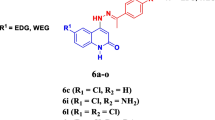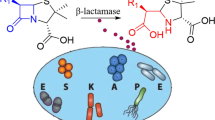Abstract
Bacterial multiresistance is a health problem worldwide that demands new antimicrobials for treating bacterial-related infections. In this study, we evaluated the antimicrobial activity and the theoretical toxicology profile of N-substituted-phenylamino-5-methyl-1H-1,2,3-triazole-4-carbohydrazide derivatives against gram-positive and gram-negative bacteria clinical strains. On that purpose we determined the minimum inhibitory (MIC) and bactericidal (MBC) concentrations, the in vitro cytotoxicity, and in silico risk profiles, also comparing with antimicrobial agents of clinical use. Among the 16 derivatives analyzed, four nitrofurans (N–H–FUR–NO2, N–Br–FUR–NO2, N–F–FUR–NO2, N–Cl–FUR–NO2) showed promising MIC and MBC values (MIC = MBC = 1–16 μg/mL). The experimental data revealed the potential of these derivatives, which were comparable to the current antimicrobials with similar bactericidal and bacteriostatic profiles. Therefore, these molecules may be feasible options to be explored for treating infections caused by multiresistant strains. Our in vitro and in silico toxicity reinforced these results as these derivatives presented low cytotoxicity against human macrophages and low theoretical risk profile for irritant and reproductive effects compared to the current antimicrobials (e.g., vancomycin and ciprofloxacin). The molecular modeling analysis also revealed positive values for their theoretical druglikeness and drugscore. The presence of a 5-nitro-2-furfur-2-yl group seems to be essential for the antimicrobial activity, which pointed these acylhydrazone derivatives as promising for designing more potent and safer compounds.


Similar content being viewed by others
References
Andrews JM (2001) Determination of minimum inhibitory concentrations. J Antimicrob Chemother 48:5–16
Angebault C, Andremont A (2013) Antimicrobial agent exposure and the emergence and spread of resistant microorganisms: issues associated with study design. Eur J Clin Microbiol Infect Dis 32:581–595
Chung MC, Bosquesi PL, dos Santos JL (2011) A prodrug approach to improve the physico-chemical properties and decrease the genotoxicity of nitro compounds. Curr Pharm Des 17:3515–3526
CLSI (2013) Performance Standards for Antimicrobial Susceptibility Testing; Twenty-Third Informational Supplement, 1st ed. Clinical & Laboratory Standards Institute
Desai S, Laddi U, Bennur R, Bennur S (2013) Synthesis and antimicrobial activities of some new 1,2,4-triazole derivatives. Indian J Chem 52:1176–1181
Freitas C, Fonseca A, Zanon U, Neves J (1987) Aspectos genéticos bioquímicos da resistência bacteriana aos antibióticos. J Infecções Hosp Prevenccão Diagnóstico E Trat Rio Jan MEDSI 207:49
Gonzalez N, Sevillano D, Alou L, Cafini F, Gimenez MJ, Gomez-Lus ML, Prieto J, Aguilar L (2013) Influence of the MBC/MIC ratio on the antibacterial activity of vancomycin versus linezolid against methicillin-resistant Staphylococcus aureus isolates in a pharmacodynamic model simulating serum and soft tissue interstitial fluid concentrations reported in diabetic patients. J Antimicrob Chemother 68:2291–2295
Goossens H, Ferech M, Vander Stichele R, Elseviers M, ESAC Project Group (2005) Outpatient antibiotic use in Europe and association with resistance: a cross-national database study. Lancet 365:579–587
Guimarães DO, da Momesso LS, Pupo MT (2010) Antibiotics: therapeutic importance and perspectives for the discovery and development of new agents. Quím Nova 33:667–679
Gu W, Wu R, Qi S, Gu C, Si F, Chen Z (2012) Synthesis and antibacterial evaluation of new N-acylhydrazone derivatives from dehydroabietic acid. Molecules 17:4634–4650
Hou T, Wang J, Zhang W, Xu X (2007) ADME evaluation in drug discovery. 7. Prediction of oral absorption by correlation and classification. J Chem Inf Model 47:208–218
Jordão AK, Sathler PC, Ferreira VF, Campos VR, de Souza MCBV, Castro HC, Lannes A, Lourenco A, Rodrigues CR, Bello ML, Lourenco MCS, Carvalho GSL, Almeida MCB, Cunha AC (2011) Synthesis, antitubercular activity, and SAR study of N-substituted-phenylamino-5-methyl-1H-1,2,3-triazole-4-carbohydrazides. Bioorg Med Chem 19:5605–5611
Jordão AK, Afonso PP, Ferreira VF, de Souza MCBV, Almeida MCB, Beltrame CO, Paiva DP, Wardell SMSV, Wardell JL, Tiekink ERT, Damaso CR, Cunha AC (2009) Antiviral evaluation of N-amino-1,2,3-triazoles against Cantagalo virus replication in cell culture. Eur J Med Chem 44:3777–3783
Jordão AK, Ferreira VF, Lima ES, de Souza MC, Carlos EC, Castro HC, Geraldo RB, Rodrigues CR, Almeida MC, Cunha AC (2009) Synthesis, antiplatelet and in silico evaluations of novel N-substituted-phenylamino-5-methyl-1H-1,2,3-triazole-4-carbohydrazides. Bioorg Med Chem 17:3713–3719
Krasner RI, Shors T (2013) The microbial challenge: a public health perspective. Jones & Bartlett Publishers, New York
Lima TB, Pinto MFS, Ribeiro SM, de Lima LA, Viana JC, Júnior NG, de Cândido ES, Dias SC, Franco OL (2013) Bacterial resistance mechanism: what proteomics can elucidate. FASEB J 27:1291–1303
Lipinski CA, Lombardo F, Dominy BW, Feeney PJ (2001) Experimental and computational approaches to estimate solubility and permeability in drug discovery and development settings. Adv Drug Deliv Rev 46:3–26
Lourenço AL, Abreu PA, Leal B, da Silva Júnior EN, Pinto AV, do Pinto MCFR, Souza AMT, Novais JS, Paiva MB, Cabral LM, Rodrigues CR, Ferreira VF, Castro HC (2011) Identification of nor-β-lapachone derivatives as potential antibacterial compounds against Enterococcus faecalis clinical strain. Curr Microbiol 62:684–689
O’Connell KMG, Hodgkinson JT, Sore HF, Welch M, Salmond GPC, Spring DR (2013) Combating multidrug-resistant bacteria: current strategies for the discovery of novel antibacterials. Angew Chem Int 52:10706–10733
Oliveira GA, Okada SS, Guenta RS, Mamizuka EM (2001) Evaluation of the tolerance to vancomycin in 395 oxacillin-resistant Staphylococcus aureus strains isolated from Brazilian hospitals. J Bras Patol E Med Lab 37:239–246
Palmer AC (2013) Gene-drug interactions and the evolution of antibiotic resistance. http://dash.harvard.edu/handle/1/10436292. Accessed 01 Dec 2013
Patrick GL (2013) An introduction to medicinal chemistry. Oxford University Press, Oxford
Payne DJ, Gwynn MN, Holmes DJ, Pompliano DL (2007) Drugs for bad bugs: confronting the challenges of antibacterial discovery. Nat Rev Drug Discov 6:29–40
McArthur MG, Waglechner N, Nizam F, Yan A, Azad MA, Baylay AJ, Bhullar K, Canova MJ, De Pascale G, Ejim L, Kalan L, King AM, Koteva K, Morar M, Mulvey MR, O'Brien JS, Pawlowski AC, Piddock LJV, Spanogiannopoulos P, Sutherland AD, Tang I, Taylor PL, Thaker M, Wang W, Yan M, Yu T, Wright GD (2013) The comprehensive antibiotic resistance database. Antimicrob Agents Chemother 57:3348–3357
Pinheiro LC, Abreu PA, Afonso IF, Leal B, Corrêa LC, Borges JC, Marques IP, Lourenço AL, Sathler P, dos Santos AL (2008) Identification of a potential lead structure for designing new antimicrobials to treat infections caused by Staphylococcus epidermidis-resistant strains. Curr Microbiol 57:463–468
Quillardet P, Arrault X, Michel V, Touati E (2006) Organ-targeted mutagenicity of nitrofurantoin in Big Blue transgenic mice. Mutagenesis 21:305–311
Quintiliani R, Quintiliani RJr (2008) Pharmacokinetics/Pharmacodynamics for critical care clinicians. Crit Care Clin 24:335–348
Roldán MD, Pérez-Reinado E, Castillo F, Moreno-Vivián C (2008) Reduction of polynitroaromatic compounds: the bacterial nitroreductases. FEMS Microbiol Rev 32:474–500
Santos DO, Lorré K, de Boer M, Van Heuverswyn H (1999) Shedding of soluble receptor for tumor necrosis factor alpha induced by M. leprae or LPS from human mononuclear cells. Nihon Hansen Gakkai Zasshi Jpn J Lepr Off Organ Jpn Lepr Assoc. 68:185–193
Skolimowski IM, Knight RC, Edwards DI (1983) Molecular basis of chloramphenicol and thiamphenicol toxicity to DNA in vitro. J Antimicrob Chemother 12:535–542
Spellberg B, Guidos R, Gilbert D, Bradley J, Boucher HW, Scheld WM, Bartlett JG, Edwards J Jr, Infectious Diseases Society of America (2008) The epidemic of antibiotic-resistant infections: a call to action for the medical community from the Infectious Diseases Society of America. Clin Infect Dis Off Publ Infect Dis Soc Am 46:155–164
Tato M, López Y, Morosini MI, Moreno-Bofarull A, Garcia-Alonso F, Gargallo-Viola D, Vila J, Cantón R (2014) Characterization of variables that may influence ozenoxacin in susceptibility testing, including MIC and MBC values. Diagn Microbiol Infect Dis 78:263–267
Turton JA, Havard AC, Robinson S, Holt DE, Andrews CM, Fagg R, Williams TC (2000) An assessment of chloramphenicol and thiamphenicol in the induction of aplastic anaemia in the BALB/c mouse. Food Chem Toxicol 38:925–938
Viodé C, Bettache N, Cenas N, Krauth-Siegel RL, Chauvière G, Bakalara N, Périé J (1999) Enzymatic reduction studies of nitroheterocycles. Biochem Pharmacol 57:549–557
Walsh C (ed) (2003) Antibiotics: actions, origins, resistance. American Society for Microbiology (ASM), Washington DC
WHO (2013) Antimicrobial resistance. http://www.who.int/mediacenter/factsheets/fs194/en. Accessed 19 Sep 2013
Paulai FR, Serrano SHP, Tavares LC (2009) Aspects of bioactivity and toxicity of nitrocompounds. Quim Nova 32:1013–1020
Acknowledgments
We thank the support of Fundação de Amparo à Pesquisa do Estado do Rio de Janeiro (FAPERJ), Conselho Nacional de Desenvolvimento Científico e Tecnológico (CNPq), Coordenação de Aperfeiçoamento de Pessoal Docente (CAPES), and Pro-reitoria de Pesquisa e Inovação da Universidade Federal Fluminense (PROPPi-UFF) for the financial support and fellowships.
Author information
Authors and Affiliations
Corresponding author
Rights and permissions
About this article
Cite this article
Lannes, A.C., Leal, B., Novais, J.S. et al. Exploring N-Acylhydrazone Derivatives Against Clinical Resistant Bacterial Strains. Curr Microbiol 69, 357–364 (2014). https://doi.org/10.1007/s00284-014-0591-y
Received:
Accepted:
Published:
Issue Date:
DOI: https://doi.org/10.1007/s00284-014-0591-y




